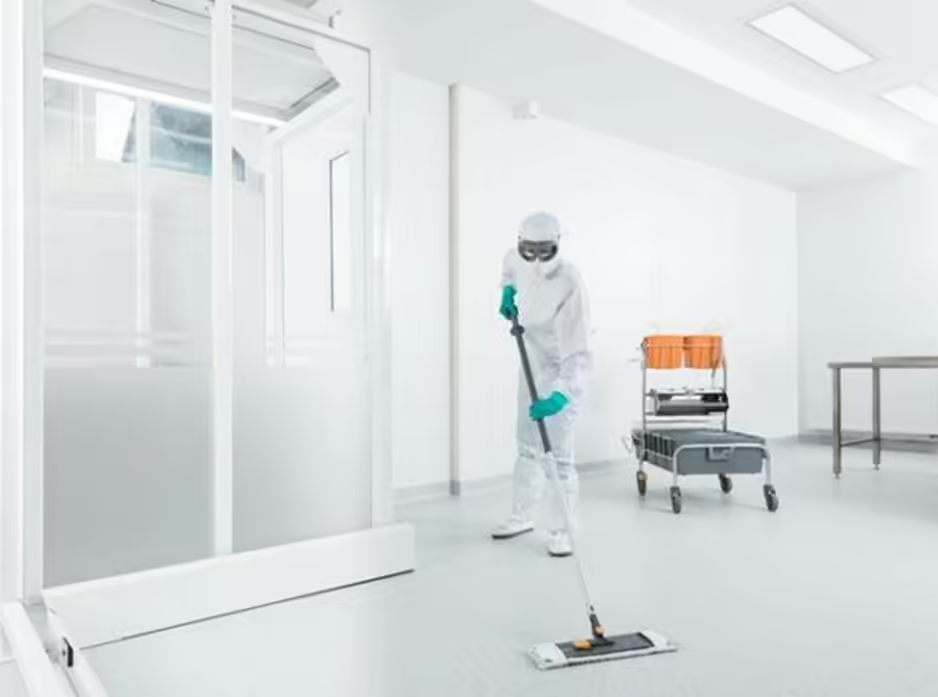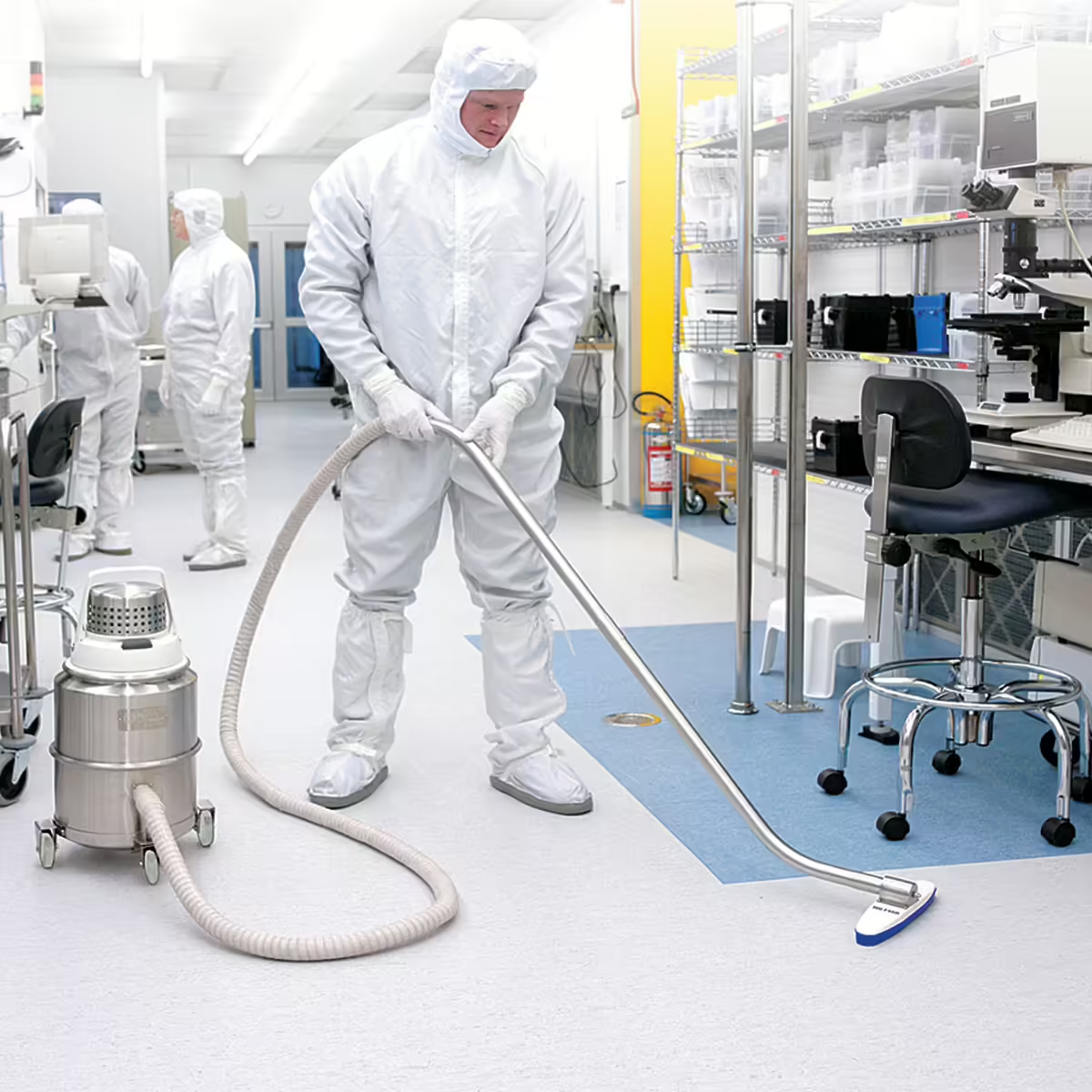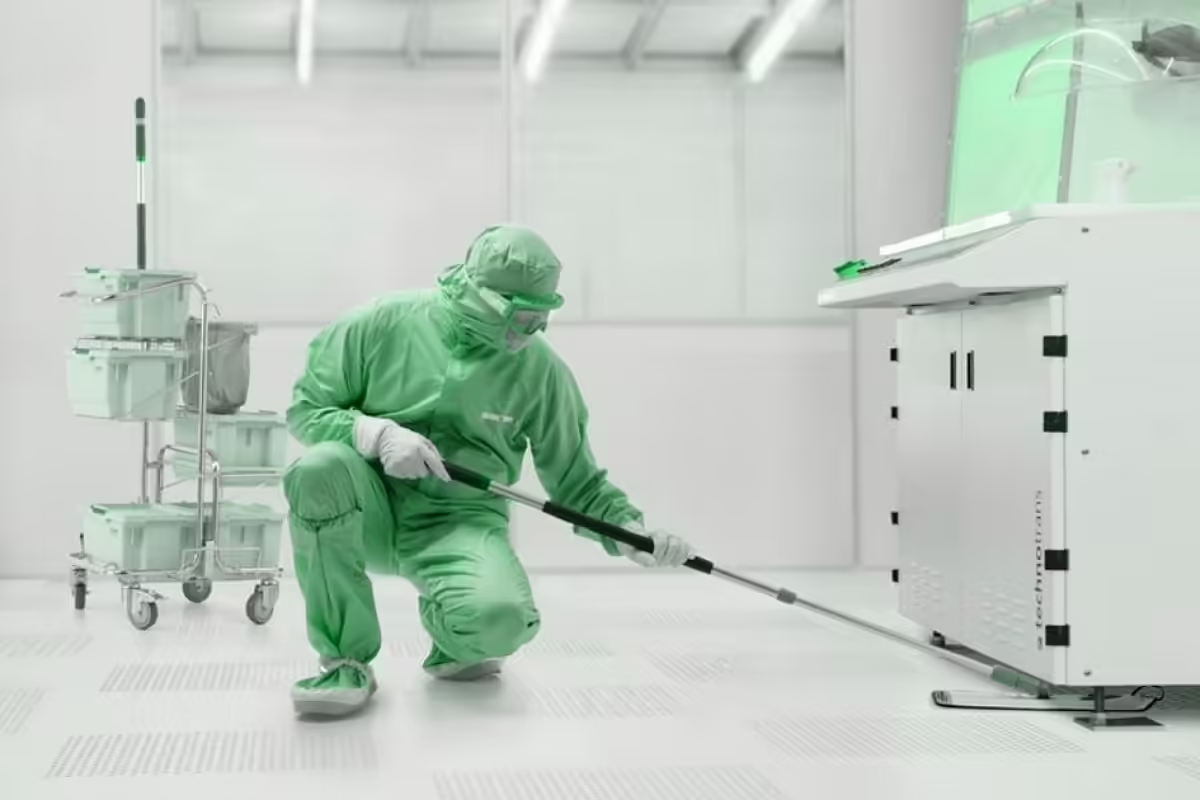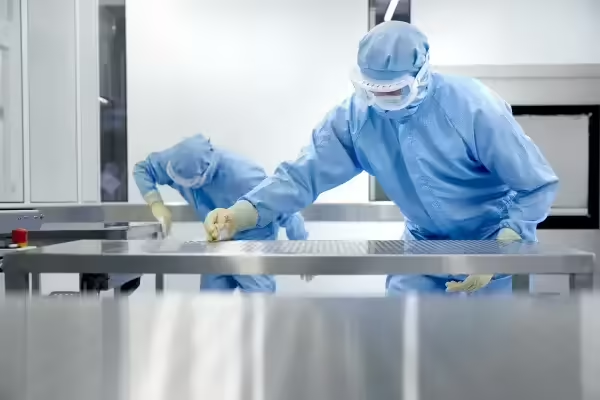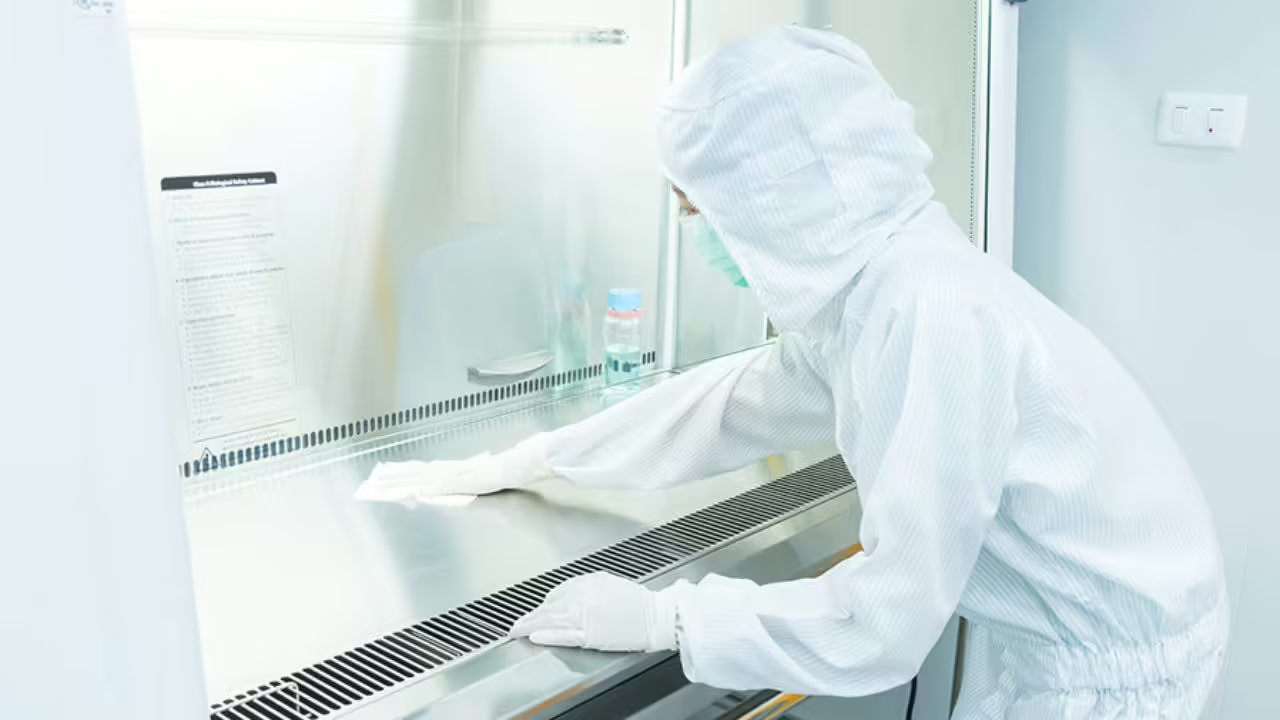SourceOne’s janitorial cleaning services for sterile environments like cleanrooms and laboratories cover the following key areas:
1. Surface Cleaning and Disinfection
Surface Cleaning and Disinfection Regular and thorough cleaning of all surfaces, including walls, floors, and ceilings. Disinfectants approved for cleanrooms and sterile environments are used to remove particulates and microbial contaminants, ensuring that surfaces are sterilized and free of contaminants. Read more here about our range of services for sterile environments. https://www.sourceonebuildingmtn.com/cleanroom-cleaning-services/
2. HEPA Vacuuming
Vacuuming with HEPA-filtered equipment helps remove airborne particles and dust from cleanroom environments. This reduces the risk of particle contamination in critical areas and ensures air quality is maintained according to ISO standards.
3. Sterile Mopping Systems
Floors are often cleaned using sterile mopping systems that ensure there is no cross-contamination. The mopping equipment is typically sterilized or disposable to meet the requirements of sterile environments.
4. Cleaning of Controlled Environments
Critical areas like controlled environments and laminar flow hoods necessitate specialized cleaning techniques. These environments also require consistent cleaning to minimize contamination, maintain sterility, and comply with industry standards like ISO 14644-1 and GMP guidelines.
5. Equipment Cleaning
Cleaning and sterilization of lab equipment, such as incubators, biosafety cabinets, and other essential tools, must be done without causing damage. Specific protocols ensure equipment remains sterile and fully functional.
6. Gowning Area Cleaning
Gowning rooms are cleaned regularly to ensure no contamination is introduced into critical environments. Cleaning includes disinfection of benches, lockers, and other surfaces.
For more detailed procedures and best practices on maintaining a clean gowning area, visit this article on Gowning Area Protocols.
7. Environmental Monitoring and Validation
Environmental monitoring, such as particle counting or surface sampling to verify that cleaning protocols are effective and the environment meets cleanliness standards.
To learn more about the importance of environmental monitoring and validation in maintaining cleanroom integrity, visit this resource on Environmental Monitoring and Validation Techniques.
Specialty Equipment Requires Specialists
Cleaning cleanrooms in any industry, from biotech to pharmaceutical to semiconductors, to medical devices, and nanotechnology, requires meticulous planning and adherence to stringent standards to ensure the integrity and sterility of the environment. For more information on the types of specialty equipment used in cleanroom environments and the standards associated with them, check out this article on Specialty Cleanroom Equipment and Standards.
Below are critical factors SourceONE considers before starting the cleaning process:
1. Understanding Cleanroom Classification
- Cleanroom Classes: It is essential to know the cleanroom classification (ISO Class 1-9 or Class 1,000-100,000) as each class has specific standards for air cleanliness, particle count, and microbial contamination.
- Regulatory Standards: We familiarize ourselves with regulatory standards like ISO 14644, GMP (Good Manufacturing Practices), and other relevant guidelines.
2. Training and Qualification of Personnel
- Specialized Training: SourceONE ensures that all personnel involved in cleaning are adequately trained in cleanroom protocols, gowning procedures, and contamination control.
- Certification: Cleanroom cleaning teams are certified in cleanroom cleaning procedures and understand the importance of maintaining sterility.
3. Proper Gowning Procedures
- Gowning Protocol: SourceONE cleaning professionals follow the applicable gowning protocols to prevent contamination. This includes wearing sterile gloves, masks, coveralls, shoe covers, and hairnets.
- Gowning Sequence: Members of the cleaning team know and follow the correct sequence for donning and doffing cleanroom garments to minimize contamination risks.
4. Cleaning Supplies and Equipment
- Approved Materials: SourceONE uses only cleaning materials and equipment approved for cleanroom use. This includes lint-free wipes, sterile mops, HEPA-filtered vacuums, and non-shedding cleaning tools.
- Cleanroom-Specific Chemicals: Ensure we use disinfectants and cleaning agents that are effective against potential contaminants and safe for cleanroom surfaces. It is also essential to make sure these chemicals are compatible with the materials used in the cleanroom.
5. Cleaning Procedures and Protocols
- Standard Operating Procedures (SOPs): We follow detailed SOPs for each cleaning task. These procedures should outline the frequency, method, and materials to be used for cleaning different areas and surfaces.
- Documentation: That we maintain thorough records of all cleaning activities, including dates, times, personnel involved, and the specific areas cleaned. Documentation is crucial for compliance and traceability.
6. Environmental Monitoring
- Particle Counting: Regular monitoring of airborne particles to ensure the cleanroom meets its classification standards.
- Microbial Monitoring: Use swabs, settle plates, and other methods to monitor microbial contamination levels on surfaces and in the air.
7. Contamination Control
- Minimize Movement: Limit movement and personnel within the cleanroom to reduce the risk of contamination.
- Airflow Management: Understand the cleanroom’s airflow patterns and avoid actions that might disrupt the laminar flow or introduce contaminants.
8. Cleaning Frequency
- Regular Intervals: Establish a cleaning schedule based on the cleanroom’s classification and usage. Some areas may require daily cleaning, while others might need weekly or monthly attention.
- Event-Based Cleaning: Perform additional cleaning after any contamination event, maintenance work, or other activities that could compromise the cleanroom’s sterility.
9. Validation and Verification
- Validation: Validate cleaning processes to ensure they effectively remove contaminants. This may involve testing cleaning agents and methods under real-world conditions.
- Verification: Regularly verify that cleaning procedures are being followed correctly and achieving the desired cleanliness levels through environmental monitoring and audits.
10. Emergency Procedures
- Spill Response: Have clear procedures in place for responding to spills or contamination events. This includes immediate cleaning, decontamination, and reporting protocols.
- Contamination Control: Understand how to handle contamination incidents to prevent the spread and ensure the cleanroom can return to operational status quickly.
Cleaning cleanrooms in the life science industry in San Jose, San Francisco, and the greater Bay area requires a comprehensive cleanroom cleaning approach to ensure that cleanrooms meet the highest standards of cleanliness and regulatory compliance. For a free consultation or to request a quote to clean your cleanrooms, please contact us now
Schedule a Complimentary Consultation
Our Cleanroom Cleaning Approach
SourceONE takes a comprehensive approach to our cleanroom cleaning services.
- Mops
Mops play an important role in the cleaning of cleanrooms, which are controlled environments where the concentration of airborne particles is regulated to specific limits. These rooms are essential in industries such as pharmaceuticals, biotechnology, and electronics, where even the smallest contaminant can affect the quality and safety of products.
-
Specialized Cleanroom Mops
Unlike traditional mops, cleanroom mops are designed to meet stringent cleanliness standards. They are typically made from materials that generate minimal particles and fibers, such as microfiber or non-woven polyester. These materials are chosen for their ability to effectively capture and hold contaminants, ensuring they are not released back into the environment during cleaning.
-
Mop Design and Features
Cleanroom mops often feature flat, rectangular heads that maximize surface contact and ensure even cleaning. The mop heads are usually detachable and can be autoclaved or sterilized to maintain cleanliness. Additionally, the mop handles are often made from stainless steel or other non-corrosive materials that are easy to clean and disinfect.
-
Cleaning Solutions and Protocols
When using mops in cleanrooms, it’s essential to follow strict cleaning protocols. The cleaning solutions used are typically low in residue and free from contaminants that could compromise the cleanroom’s integrity. These solutions are applied to the mop head, which is then used in a systematic pattern to cover the entire floor area without missing spots or spreading contaminants.
-
Benefits of Mopping in Cleanrooms
Mopping helps to remove particles, dust, and microbial contaminants from the floors, maintaining the cleanroom’s controlled environment. Regular mopping reduces the risk of contamination that could affect sensitive processes or products. It also helps to extend the life of cleanroom surfaces by preventing the buildup of harmful substances.
Conclusion
Mops are an indispensable tool in the maintenance of cleanrooms, ensuring that these critical environments remain free from contaminants. By using specialized materials and following stringent cleaning protocols, mops help uphold the cleanliness standards required for high-precision industries.
- Vacuums
Vacuum cleaners are integral to maintaining the stringent cleanliness standards of cleanrooms, which are critical in industries like pharmaceuticals, biotechnology, and semiconductor manufacturing. These controlled environments require meticulous cleaning to prevent contamination that could compromise product quality and safety. Vacuum cleaners designed for cleanrooms differ significantly from conventional models to meet these high standards.
-
Specialized Cleanroom Vacuum Cleaners
Cleanroom vacuum cleaners are engineered to control and minimize particle emissions. They typically feature HEPA (High-Efficiency Particulate Air) or ULPA (Ultra-Low Penetration Air) filters, which can capture 99.97% to 99.999% of particles as small as 0.3 microns. These filters ensure that the vacuum does not release contaminants back into the air, which is crucial in maintaining the cleanroom’s particle count within the specified limits.
-
Design and Construction
The construction of cleanroom vacuum cleaners involves materials that do not shed particles or contribute to contamination. Stainless steel and other non-corrosive, easily cleanable materials are commonly used. These vacuums are also designed to be easy to disassemble and sterilize, ensuring that every component can be thoroughly cleaned to maintain hygiene standards.
-
Operation and Protocols
Using vacuum cleaners in cleanrooms follows strict protocols. Operators are trained to use these vacuums in a manner that prevents the spread of contaminants. This includes vacuuming in a specific pattern to ensure complete coverage and using attachments designed for different surfaces, such as floors, walls, and equipment. Vacuum cleaners are often equipped with antistatic features to prevent static discharge, which can attract dust and particles.
-
Applications and Benefits
Vacuum cleaners are used to remove dust, particles, and other contaminants from various surfaces within cleanrooms, including floors, workstations, and equipment. Regular vacuuming is essential to maintain the cleanroom’s air quality and surface cleanliness, preventing contamination of products and processes. This is especially important in industries where even microscopic particles can have significant adverse effects.
Conclusion
Vacuum cleaners play a vital role in the maintenance of cleanrooms, ensuring that these environments remain free from harmful contaminants. By using specialized equipment designed to capture and contain particles, cleanroom vacuums help maintain the strict cleanliness standards required in high-precision industries. Their effective operation ensures the integrity and safety of products and processes, supporting the overall quality and reliability of outcomes in sensitive manufacturing and research environments.
-
Cleaners
The use of green cleaners and chemicals in cleanrooms is an important advancement for maintaining high cleanliness standards while promoting environmental sustainability and health safety. Cleanrooms are highly controlled environments used in industries like pharmaceuticals, biotechnology, and semiconductor manufacturing, where even minor contaminants can compromise product quality and safety. Green cleaners are designed to be effective while minimizing harmful environmental and health impacts.
-
Characteristics of Green Cleaners
Green cleaners are typically made from biodegradable, non-toxic, and renewable resources. They avoid harmful ingredients, such as volatile organic compounds (VOCs), which can cause health issues and environmental damage. These cleaners are formulated to be just as effective as traditional cleaning agents in removing contaminants like particles, microbes, and residues, ensuring that cleanrooms maintain their stringent standards.
-
Benefits to Health and Safety
Green cleaners enhance the health and safety of employees by reducing exposure to harsh chemicals that can cause respiratory issues, skin irritation, and other health problems. This is particularly important in cleanrooms, where maintaining a sterile environment is crucial, and the well-being of workers directly impacts productivity and product integrity.
-
Environmental Impact
Using green cleaners reduces the ecological footprint of cleanroom operations. Traditional cleaning chemicals can contribute to water and soil pollution when disposed of improperly. In contrast, green cleaners break down more easily and pose less risk to the environment, aligning with sustainability and corporate social responsibility goals.
-
Implementation in Cleanrooms
Implementing green cleaning in cleanrooms requires proper training and updated protocols. Cleaning staff need to understand the specific properties of green cleaners, including correct dilution ratios, application methods, and contact times. Continuous monitoring and documentation ensure the effectiveness of green cleaning practices, maintaining high standards and regulatory compliance.
Schedule a Complimentary Consultation
Conclusion
The adoption of green cleaners in cleanrooms is a significant step toward achieving stringent cleanliness standards while supporting environmental and health goals. By integrating eco-friendly practices, cleanrooms can maintain their critical environments without compromising on safety or sustainability.
- Water
The use of deionized (DI) or reverse osmosis (RO) filtered water in cleanrooms is essential for maintaining the stringent cleanliness standards required in these controlled environments. Cleanrooms are used in various high-tech industries, such as pharmaceuticals, biotechnology, and semiconductor manufacturing, where even microscopic contaminants can jeopardize the quality and integrity of products. DI and RO water play a crucial role in ensuring that cleaning processes do not introduce impurities that could compromise the cleanroom’s controlled conditions.
-
Characteristics of Deionized and Reverse Osmosis Water
Deionized Water: Deionized water is produced by passing water through a resin bed that removes ions. This process removes minerals, such as calcium, magnesium, sodium, and chloride, resulting in water that is free from ionic impurities. DI water is highly pure and does not contain dissolved salts that can leave residues.
Reverse Osmosis Water: Reverse osmosis water is created by forcing water through a semi-permeable membrane that removes a wide range of contaminants, including ions, particles, and organic molecules. RO filtration effectively reduces the concentration of dissolved solids, bacteria, and other impurities, producing water of very high purity.
-
Importance of Pure Water in Cleanrooms
- Prevention of Contamination: In cleanrooms, the presence of even the smallest contaminants can affect the outcome of sensitive processes and the quality of products. Using DI or RO water ensures that cleaning activities do not introduce ionic or particulate impurities. This is crucial for maintaining the controlled environment required in cleanrooms.
- Residue-Free Cleaning: Traditional tap water contains minerals and other dissolved substances that can leave residues on surfaces. These residues can interfere with cleanroom processes and equipment. DI and RO water, being free of these impurities, do not leave any residues, ensuring that surfaces remain clean and uncontaminated after cleaning.
- Compatibility with Sensitive Materials: Cleanrooms often contain delicate and sensitive equipment and materials that can be adversely affected by contaminants. The use of DI and RO water is particularly important in such environments because it prevents corrosion, scaling, and other damage that can be caused by impurities in regular water.
-
Applications in Cleanroom Cleaning
Surface Cleaning: DI and RO water are used to clean surfaces such as floors, walls, and equipment in cleanrooms. The high purity of the water ensures that no contaminants are introduced during the cleaning process, maintaining the cleanroom’s stringent cleanliness standards.
Wiping and Mopping: When used with lint-free wipes and mops, DI and RO water provide effective cleaning without leaving residues. This combination is essential for removing dust, particles, and other contaminants from critical surfaces.
Rinsing: After applying cleaning agents, DI and RO water are often used for rinsing to ensure that no residues from the cleaning chemicals remain on surfaces. This final rinse is crucial for maintaining the cleanliness and sterility of the cleanroom environment.
Equipment Cleaning: Sensitive equipment and instruments in cleanrooms require meticulous cleaning to prevent contamination. DI and RO water are ideal for cleaning and rinsing these items, as they do not leave residues that could affect equipment performance.
-
Benefits of Using DI and RO Water
- Enhanced Cleanliness: The use of DI and RO water significantly enhances the cleanliness of cleanrooms by eliminating the risk of introducing contaminants during cleaning.
- Improved Product Quality: By maintaining a contaminant-free environment, DI and RO water help ensure the quality and integrity of products manufactured in cleanrooms.
- Extended Equipment Life: The absence of minerals and other impurities in DI and RO water prevents scaling and corrosion, thus extending the life of cleanroom equipment and surfaces.
- Regulatory Compliance: Many industries have stringent regulatory requirements for cleanliness and contamination control. The use of DI and RO water helps meet these standards, ensuring compliance with industry regulations.
Conclusion
The use of deionized and reverse osmosis filtered water is a critical component of cleanroom maintenance. These high-purity water types ensure that cleaning processes do not introduce contaminants, thereby maintaining the stringent cleanliness standards required in cleanroom environments. By preventing residue buildup, protecting sensitive equipment, and supporting regulatory compliance, DI and RO water play an essential role in the effective and efficient operation of cleanrooms across various high-tech industrie.
- Wipes
The use of wipes in cleanrooms is a fundamental aspect of maintaining the stringent cleanliness standards required in these controlled environments. Cleanrooms are critical in industries such as pharmaceuticals, biotechnology, and semiconductor manufacturing, where even microscopic contaminants can compromise product quality and safety. Specialized wipes play a crucial role in effectively removing contaminants without introducing new ones.
-
Types of Cleanroom Wipes
Non-Woven Wipes: These are made from synthetic fibers like polyester and polypropylene. They are durable, highly absorbent, and effective at trapping particles without shedding fibers.
Knitted Wipes: Typically made from continuous-filament polyester, knitted wipes are designed to be low-linting and highly absorbent. They are ideal for critical cleaning tasks that require minimal particle generation.
Pre-Saturated Wipes: These wipes come pre-moistened with a precise amount of cleaning solution, ensuring consistent application and reducing the risk of contamination from external sources.
-
Applications of Cleanroom Wipes
Surface Cleaning: Wipes are used to clean surfaces such as workstations, equipment, walls, and floors. Their ability to remove dust, particles, and residues ensures that surfaces remain free of contaminants.
Equipment Maintenance: Wipes are essential for cleaning sensitive equipment and instruments. Their low-lint properties prevent the introduction of fibers that could affect equipment performance.
Disinfection: Pre-saturated wipes with disinfectants are used to sanitize surfaces, effectively killing bacteria and other microbes to maintain a sterile environment.
Spill Control: Wipes are used to quickly address spills, preventing the spread of contaminants and ensuring that the cleanroom remains free from liquid hazards.
-
Benefits of Using Cleanroom Wipes
- Effective Contamination Control: Specialized wipes are designed to capture and hold contaminants, reducing the risk of recontamination.
- Material Compatibility: Cleanroom wipes are made from materials that are safe for use on sensitive surfaces and equipment.
- Convenience and Efficiency: Wipes are easy to use, allowing for quick and effective cleaning of various surfaces.
- Consistent Quality: Pre-saturated wipes provide consistent application of cleaning solutions, ensuring uniform cleanliness.
Conclusion
Cleanroom wipes are an indispensable tool in maintaining the high cleanliness standards required in controlled environments. Their specialized design and materials ensure effective contamination control, protecting the integrity of processes and products in cleanrooms.
ENVIRONMENTS WE SPECIALIZE IN
Bio-pharmaceutical
SourceONE Building Maintenance specializes in bio-pharmaceutical environments due to the critical need for exceptional cleanliness and stringent contamination control in these settings.
Bio-pharmaceutical facilities produce highly sensitive products, such as vaccines, monoclonal antibodies, and gene therapies, where even minor contamination can compromise product safety and efficacy.
SourceONE’s expertise ensures these environments meet the rigorous standards set by regulatory agencies like the FDA and EMA. The company employs advanced cleaning protocols, specialized equipment, and highly trained personnel to maintain the pristine conditions required in cleanrooms and other controlled areas. Our cleaning teams understand the unique challenges of handling biological materials and adhere to strict protocols to prevent cross-contamination.
By specializing in bio-pharmaceutical environments, SourceONE Building Maintenance provides invaluable support to these critical industries, ensuring that their facilities remain in optimal condition for the development and production of life-saving therapies.
For more information on our bio-pharmaceutical cleaning services and how we maintain exceptional cleanliness and contamination control, visit our services overview page.
Semiconductor/Microelectronics
SourceONE Building Maintenance specializes in Semiconductor/Microelectronics environments due to the critical need for precise contamination control in these highly sensitive industries.
Semiconductor and microelectronics manufacturing requires extremely clean environments because even microscopic particles can cause defects in circuits and components, leading to significant product failures and financial losses.
SourceONE’s expertise ensures these environments maintain the stringent cleanliness standards necessary for optimal performance. The company employs advanced cleaning protocols, specialized equipment, and highly trained personnel to manage the unique challenges of these settings. Our teams understand the delicate nature of semiconductor materials and the importance of preventing particle, chemical, and microbial contamination.By specializing in these environments, SourceONE Building Maintenance provides essential support to semiconductor and microelectronics manufacturers, helping them maintain the high standards needed for the production of cutting-edge technology. This expertise not only safeguards product quality but also enhances operational efficiency and reliability, ensuring that manufacturers can meet the stringent demands of the market.
To learn more about our cleaning solutions for semiconductor and microelectronics environments and how we ensure optimal cleanliness and contamination control, visit our dedicated services page.
Medical Devices
SourceONE Building Maintenance specializes in the cleaning of medical devices due to the critical need for maintaining stringent hygiene and contamination control in this sector.
Medical devices, ranging from surgical instruments to diagnostic equipment, must meet rigorous cleanliness standards to ensure patient safety and device efficacy. Even minimal contamination can lead to severe health risks and compromise device functionality.
SourceONE’s expertise ensures that medical device manufacturing and processing environments adhere to the strict regulatory standards set by agencies such as the FDA. The company employs advanced cleaning protocols, specialized equipment, and highly trained personnel to manage the unique challenges associated with cleaning medical devices. Our teams are well-versed in the specific requirements for preventing microbial contamination, particulate matter, and chemical residues.
By specializing in the cleaning of medical devices, SourceONE Building Maintenance provides crucial support to the healthcare industry, ensuring that devices are safe for use and meet the highest quality standards, ultimately protecting patient health and improving clinical outcomes.
Nanotechnology
SourceONE Building Maintenance specializes in nanotechnology environments due to the unique and stringent cleanliness requirements essential for this cutting-edge field.
Nanotechnology involves the manipulation of materials at an atomic or molecular scale, where even the smallest particles of contamination can significantly impact the precision and functionality of nanomaterials and devices.
SourceONE’s expertise ensures that these highly controlled environments maintain the exceptional cleanliness standards necessary for successful nanotechnology research and manufacturing. The company employs advanced cleaning protocols, state-of-the-art equipment, and highly trained personnel skilled in managing the specific challenges of nanotechnology cleanrooms. Our teams understand the critical importance of eliminating all forms of contaminants, including dust, chemical residues, and microbial particles, which can affect the integrity and performance of nanoscale products.
By specializing in nanotechnology environments, SourceONE Building Maintenance provides essential support to researchers and manufacturers, helping them achieve the high standards needed for innovative advancements in this rapidly evolving field. This expertise ensures the purity and quality of nanomaterials, fostering successful development and application of nanotechnology.
Biotechnology
SourceONE Building Maintenance specializes in biotechnology environments due to the critical need for maintaining stringent cleanliness and contamination control in these specialized settings.
Biotechnology encompasses a broad range of disciplines where biological systems, living organisms, or derivatives thereof are utilized to develop products or processes for various applications, including healthcare, agriculture, and environmental remediation.
In biotechnology facilities, cleanliness is paramount to ensure the purity and safety of biological materials and products. Even minor contaminants can compromise research outcomes, production processes, and the quality of biopharmaceuticals, vaccines, and diagnostic tools.
SourceONE’s expertise ensures that biotechnology environments adhere to rigorous regulatory standards and industry best practices. We employ advanced cleaning protocols, specialized equipment, and highly trained personnel to manage the unique challenges associated with maintaining cleanliness in biotechnology cleanrooms and laboratories. Our teams understand the critical importance of preventing cross-contamination, maintaining sterility, and ensuring the integrity of biological samples and processes.
Moreover, SourceONE’s specialization supports biotechnology companies in achieving reliable and reproducible results, fostering innovation and advancement in the field while ensuring safety and efficacy in biotechnological applications.
The use of green cleaners and chemicals in the cleaning of cleanrooms represents a significant advancement in maintaining stringent cleanliness standards while prioritizing environmental sustainability and health safety. Cleanrooms are highly controlled environments used in industries such as pharmaceuticals, biotechnology, and semiconductor manufacturing, where even the smallest contaminants can compromise product integrity and safety. Integrating green cleaning practices in such sensitive environments ensures that the cleaning processes do not introduce harmful substances, thus preserving both the cleanroom’s integrity and the broader ecological system.
What Are Green Cleaners and Chemicals?
Green cleaners and chemicals are cleaning products designed to have a minimal environmental impact. They are typically made from biodegradable, non-toxic, and renewable resources. Unlike conventional cleaning agents that may contain harmful chemicals, green cleaners avoid ingredients that can release volatile organic compounds (VOCs), which can be detrimental to human health and the environment. These eco-friendly products are formulated to be effective at cleaning while being gentle on surfaces and safe for use around people.
Importance of Green Cleaners in Cleanrooms
Health and Safety
One of the primary reasons for using green cleaners in cleanrooms is to ensure the health and safety of employees who work in these environments. Traditional cleaning agents can contain harsh chemicals that may cause respiratory issues, skin irritation, and other health problems. By switching to green cleaners, facilities can reduce the exposure of their staff to these harmful substances, promoting a healthier workplace.
Environmental Impact
Green cleaners reduce the ecological footprint of cleanroom operations. Traditional cleaning chemicals can contribute to water and soil pollution when they are washed down drains or disposed of improperly. In contrast, green cleaners are designed to break down more easily and pose less risk to the environment. This aligns with the growing emphasis on sustainability and corporate social responsibility in many industries.
Efficacy and Standards
Meeting Cleanroom Standards
Green cleaners must meet the same rigorous standards as traditional cleaning agents to be suitable for use in cleanrooms. This means they must be effective at removing contaminants, including particles, microbes, and residues, without compromising the cleanroom’s controlled environment. Many green cleaners are now formulated to be just as effective as their conventional counterparts, ensuring that cleanliness and sterility are maintained.
Compatibility with Cleanroom Materials
Another critical factor is that green cleaners must be compatible with the sensitive materials and surfaces found in cleanrooms. This includes being non-corrosive and non-reactive with the specialized equipment and surfaces, such as stainless steel, glass, and certain plastics. Green cleaning products are typically tested for these qualities to ensure they do not damage or degrade the materials they come into contact with.
Implementation and Best Practices
Training and Education
Implementing green cleaning in cleanrooms requires proper training and education for the cleaning staff. They need to understand the specific properties of green cleaners and how to use them effectively. This includes the correct dilution ratios, application methods, and contact times to ensure optimal performance.
Cleaning Protocols
Adopting green cleaning involves updating cleaning protocols to integrate the use of eco-friendly products. This might include scheduling regular training sessions, conducting audits to ensure compliance, and keeping abreast of new developments in green cleaning technologies and products.
Monitoring and Documentation
Continuous monitoring and documentation are crucial to ensure the effectiveness of green cleaning practices in cleanrooms. This involves regularly testing surfaces and air quality to ensure that contamination levels remain within acceptable limits. Detailed records of cleaning schedules, products used, and any incidents or deviations help maintain high standards and facilitate regulatory compliance.
Benefits of Green Cleaners in Cleanrooms
Enhanced Air Quality
Using green cleaners can improve indoor air quality by reducing the release of VOCs and other harmful substances. This creates a safer and more comfortable environment for employees and helps maintain the stringent air quality standards required in cleanrooms.
Corporate Image and Compliance
Adopting green cleaning practices enhances a company’s image as a responsible and forward-thinking organization. It demonstrates a commitment to sustainability and employee welfare, which can be appealing to customers, investors, and regulatory bodies. Furthermore, it can aid in compliance with environmental regulations and standards, which are becoming increasingly stringent worldwide.
Long-term Cost Savings
Although green cleaning products may have a higher upfront cost, they can lead to long-term savings. Reduced health issues among staff can lower absenteeism and healthcare costs. Additionally, green cleaners are often more concentrated, meaning that smaller amounts are needed per use, and they can help preserve the longevity of cleanroom materials and equipment.
Schedule a Complimentary Consultation
Conclusion
The use of green cleaners and chemicals in cleanrooms is a significant step toward balancing the need for stringent cleanliness and environmental sustainability. By prioritizing health, safety, and ecological impact, green cleaning practices contribute to a more sustainable and responsible operation. Through careful selection, implementation, and monitoring, green cleaners can effectively maintain the integrity of cleanroom environments while supporting broader environmental and health goals.
For more information on the benefits and types of eco-friendly cleaning products, check out this article on What Are Green Cleaners and Chemicals?
















